New skyscraper, built to be an environmental marvel, is already dated
Sign up now: Get ST's newsletters delivered to your inbox
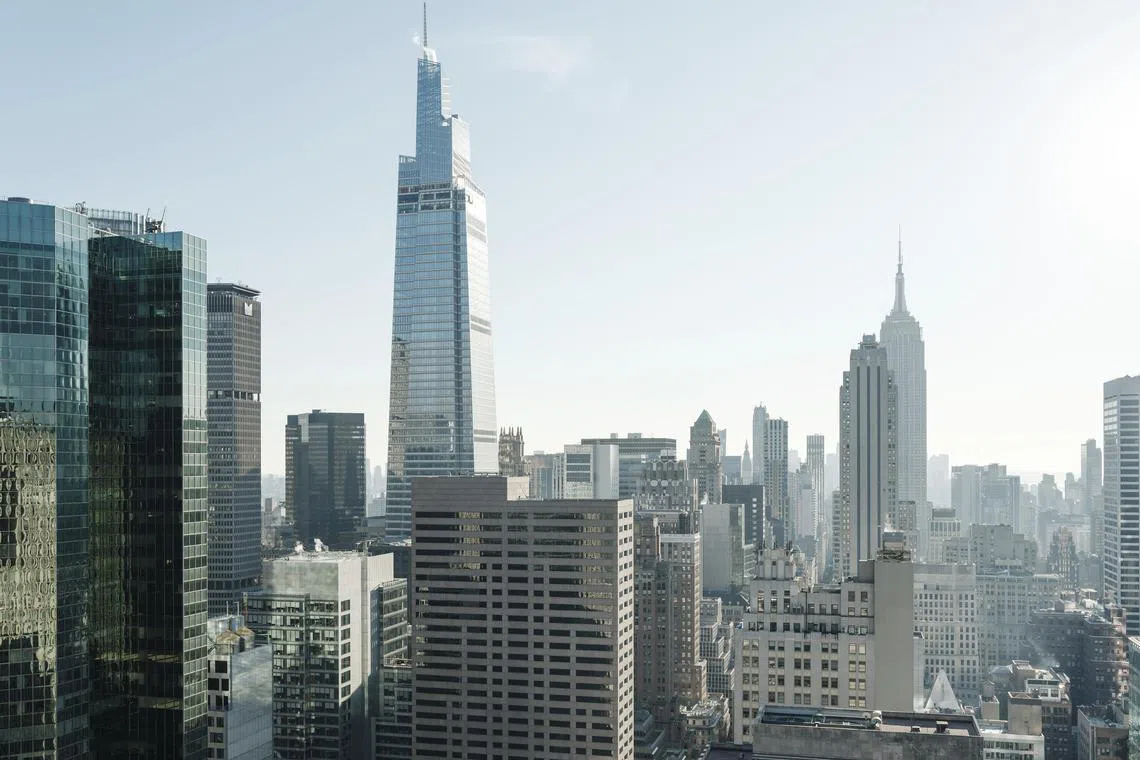
One Vanderbilt (centre left) is built to be especially climate friendly, but the design landscape is changing so quickly that some features are now oudated.
PHOTO: NYTIMES
Follow topic:
NEW YORK – One Vanderbilt, a commanding new skyscraper in the heart of Manhattan, seems to be reaching for the future. One of the world’s tallest buildings, it pierces the sky like an inverted icicle and fuses seamlessly with an expanding network of trains and other transport at its foundations.
It is also the rare skyscraper designed with climate change in mind. It holds a self-contained, catastrophe-resilient power plant capable of generating as much energy as six football fields of solar panels. The building captures every drop of rain that falls on it, and reuses that run-off to heat or cool its 9,000 daily visitors.
“It’s a commercial-grade science project,” said Mr Jonathan Wilcox, a director of engineering at SL Green Realty, the company that owns it.
But One Vanderbilt is also something else. It is already out of date.
Some of the building’s most important green features were the right answer to the climate problem in 2016, when design work was completed. “And then the answer changed,” said Mr Wilcox.
Unlike many skyscrapers, One Vanderbilt generates much of its own electricity. This was a leap forward a decade or so ago – a way of producing power that saved money for landlords and was cleaner than the local grid.
However, One Vanderbilt’s turbines burn natural gas. While natural gas is cleaner than oil or coal, it is falling out of favour,
As that transition happened, SL Green was caught in the middle. Although One Vanderbilt went up relatively quickly, topping out after three years, its owner had to watch as the city’s environmental strategy raced forward.
“Design horizons are longer than people think,” said Mr John Mandyck, chief executive of the Urban Green Council, a non-profit advocacy group.
Still, Mr Mandyck had praise for One Vanderbilt’s climate goals. “We have to celebrate the march of progress,” he said.
The 77-storey building, 20 years in the making, sits just west of Grand Central Station. Given its marquee location and remarkable ambitions, it opened in late 2020 to less fanfare than one would imagine. At the time, the Covid-19 pandemic was raging and few were in the mood to celebrate a new office tower.
Since then, One Vanderbilt has garnered its share of acclaim, thanks to a popular viewing platform and the transformation of a congested block of Vanderbilt Avenue at the foot of the building into a car-free pedestrian plaza. Its underground plaza is an integral part of East Side Access, merging with the decades-in-the-making nexus of connections between Long Island Rail Road and Grand Central Station, which finally opened in January.
But the building’s flashiest components lie hidden from public view.

Jonathan Wilcox, a director of engineering at SL Green Realty Corp., the company that owns One Vanderbilt, in New York, on Dec 5, 2022.
PHOTO: NYTIMES
On the roof, some 400m above midtown, cooling towers the size of a Brooklyn brownstone evaporate warm water pumped a quarter-mile skywards, discharging a haze similar to that of a football player removing his helmet in February. Like almost everything in One Vanderbilt, the process is not wasted. After losing its heat, the water is sent back downwards to cool off machinery dozens of floors below.
On a recent morning, Mr Wilcox and a trio of engineers huddled on the roof, their backs to the sort of knee-buckling view that tourists pay hundreds of dollars to experience from a helicopter. Nearby, five giant fans inside the cooling tower, each the size of a small windmill, quietly spun, recycling energy through the building.
One Vanderbilt is an example of a new type of office building in which sustainability is front and centre in luring tenants, who want to be assured that in addition to enjoying views all the way to the Governor Mario M. Cuomo Bridge and proximity to world-class sushi, their carbon footprint will not tickle their conscience.
The truth is that most buildings in New York, big or small, old or new, are bad for the environment. Boilers and furnaces burning fuel in basements are the city’s single largest producer of carbon dioxide, emitting more than double the amount from millions of cars and trucks on its roads.
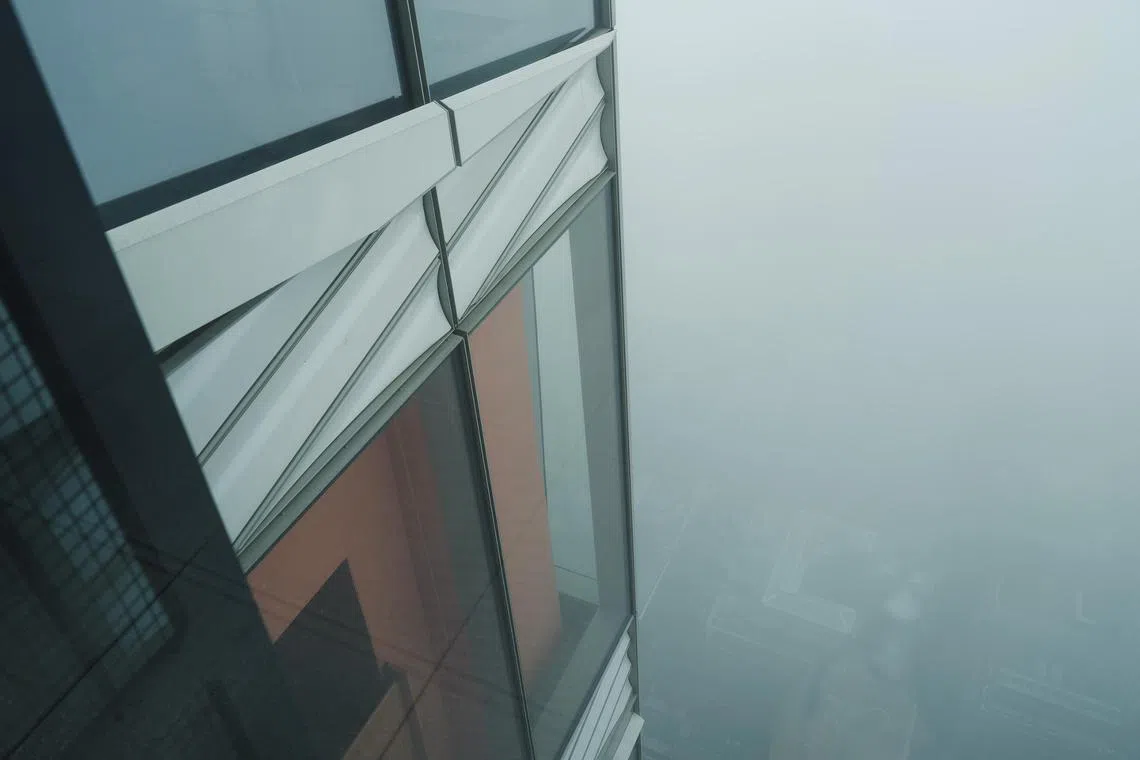
White terra-cotta panels designed to capture and reclaim rainwater on the facade of One Vanderbilt, in New York, on Dec 5, 2022.
PHOTO: NYTIMES
One Vanderbilt, according to its owner, is designed to be more energy-efficient than most new buildings. The structure features several design elements, some exorbitantly expensive, to minimise energy use, such as high ceilings to let in more natural light.
Yet because of the rapidly evolving energy-policy landscape, driven by increasing global concern over climate change, even the most ambitious attempts at sustainability often find themselves facing the possibility of retrofitting the moment the elevator doors open. One Vanderbilt is one such case.
SL Green is New York’s largest commercial landlord, with icons such as the Lipstick Building and Eleven Madison (the former Metropolitan Life North Building) in its trophy case. Its chief executive, Mr Marc Holliday, said: “Our stock-in-trade for many years was taking older buildings, redeveloping them and making them energy efficient.”
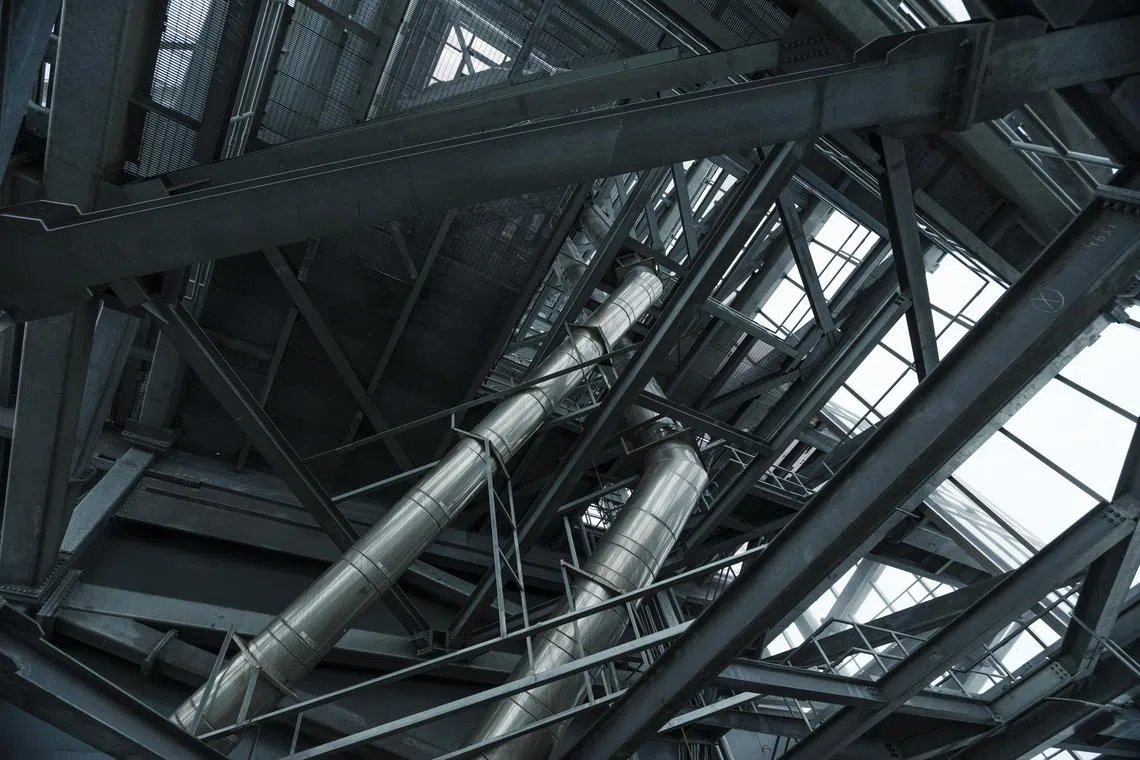
Two exhaust flues, including one for the electrical turbines, rising skyward, at One Vanderbilt.
PHOTO: NYTIMES
One Vanderbilt presented the company with a rare opportunity: blank, prime real estate in the heart of Manhattan, with a flood of natural light (meaning less need for electric lights) thanks to neighbouring Grand Central – a low-rise, landmark building – and the fact that 42nd Street to its south is a hefty five lanes wide.
Being just steps from the country’s second-busiest train station added to the sense of opportunity. SL Green spent US$220 million (S$294 million) on transit improvements near the building, partly because of the company’s belief in putting “density where density belongs”, said Mr Holliday.
One striking aspect of One Vanderbilt’s design is its stormwater reclamation system. Rain that touches its terracotta and glass facade is transferred to a pair of giant concrete bathtubs and pumped to the cooling towers above.
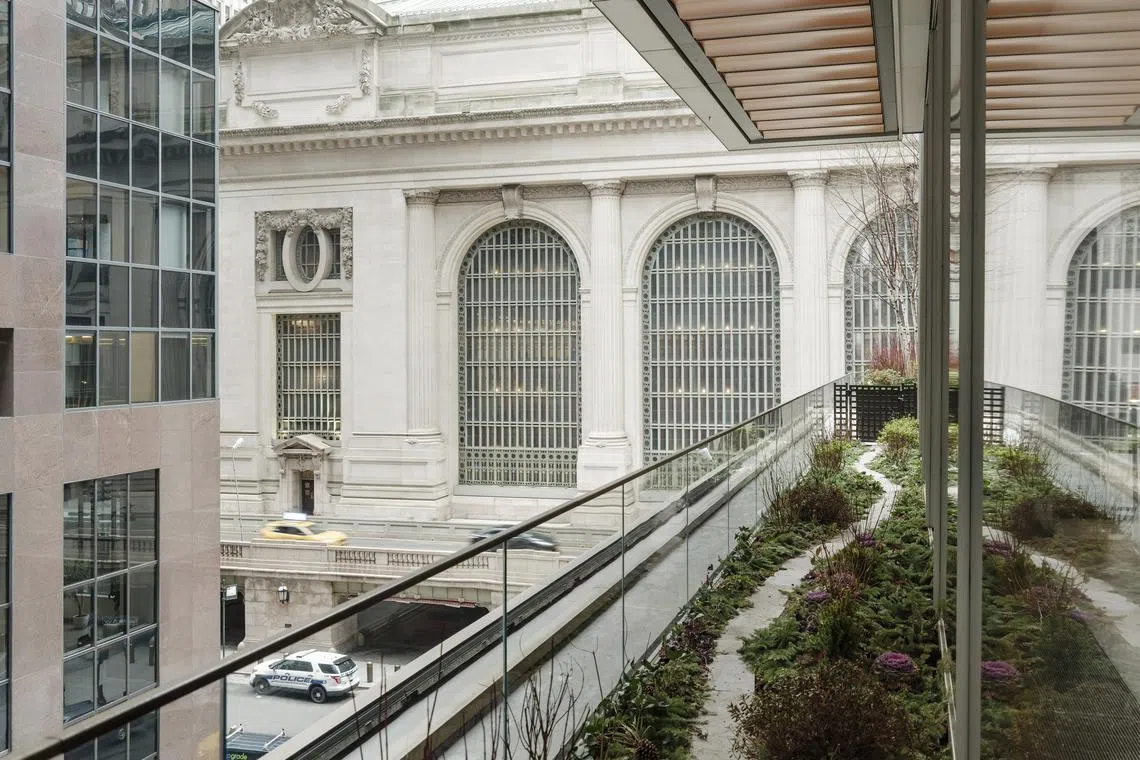
A third-floor terrace designed to capture rainwater for reuse in the heating and cooling system at One Vanderbilt.
PHOTO: NYTIMES
“Everything that falls on us reaches our roof,” said Mr Wilcox. Some run-off is evaporated, but much is used to cool the building’s power plant or is recirculated throughout the building. So far, none has been released into the sewer system, an added benefit in a city where sewers can be overwhelmed by heavy rainfall.
One Vanderbilt’s power plant creates electricity as well as hot water. The generators are hidden some 39 floors in the sky, in a windowless room halfway up the tower. “If you’re a gear head, this is awesome,” said Mr Wilcox, opening a soundproof door.
Immediately, the sound went from a skyscraper hush to the din of an airport runway. Inside stood a shipping-container-size box holding a microturbine – effectively, a jet engine. A control panel showed it spinning at 61,000 revolutions per minute. Five more turbines throbbed nearby. Colourful pipes snaked off in every direction.

A series of pipes on the 73rd floor of One Vanderbilt carry hot water and heat away from the building’s power generators, which produce their own electricity using natural gas.
PHOTO: NYTIMES
The building’s efficiency, compared with the lumbering machinery of old, has helped One Vanderbilt fill a wall with sustainability awards.
Still, the pace of change has accelerated.
“In the nineties and the aughts, the energy grid was pretty dirty,” said Ms Fiona Cousins, a mechanical engineer with Arup, a British firm involved in designing many New York buildings. As coal and oil were phased out, energy efficiency became the goal, she said, and natural gas fit the bill.
But then, “people started getting really interested in climate change”, Ms Cousins said, putting broad new emphasis on hydropower, wind and solar instead of burning a fossil fuel like gas.
Natural gas contains methane, a powerful global warming agent. And of course when it is burned, it produces carbon dioxide, the main greenhouse gas warming the world.
“This building is clearly a showpiece,” said Dr Richard Leigh, a professor of physics at Pratt Institute in Brooklyn. “The question is what it’s putting out in the way of emissions.”
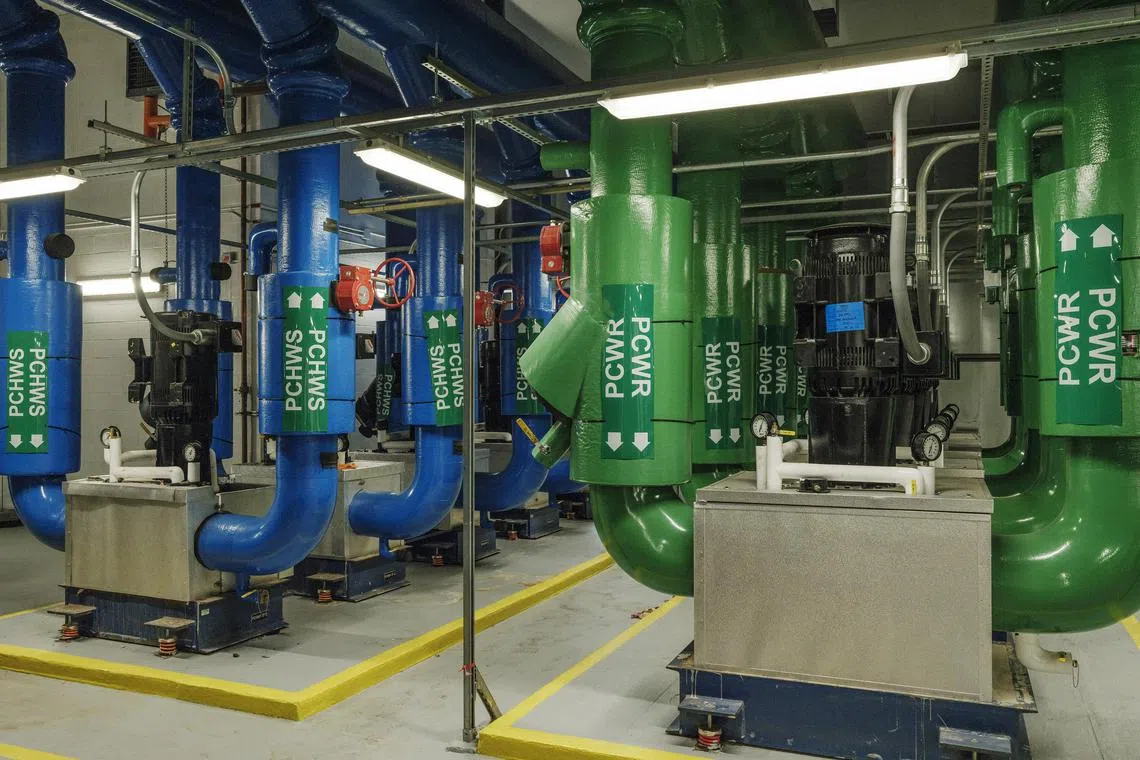
Blue pipes, with chilled water, and green pipes, with condenser water, on the 17th floor of One Vanderbilt, which captures every drop of rain and reuses the runoff to heat or cool its 9,000 daily visitors.
PHOTO: NYTIMES
Landlords such as SL Green say New York City’s new laws will force dramatic changes. Unlike energy codes of the past, one of the key laws, which restricts pollution, does not merely apply to new construction: Existing buildings, no matter how small or how old, must gradually comply and retrofit as well, potentially at eye-watering cost. Like SL Green, all New York landlords will be forced to face an uncertain future and stark choices.
For now, the future of New York’s office towers can be seen at 270 Park, a half-finished behemoth rising a few blocks north of One Vanderbilt. It will have no gas line at all. When it opens, it will be the city’s greenest skyscraper ever, owing to the city legislation banning fossil fuels in new construction – rules that did not exist when One Vanderbilt was being conceived.
The law, passed in 2021, is new enough that the city, in fact, is still working out enforcement details.
“In recent weeks, we have reached several important milestones on the implementation of this law,” said Ms Laura Popa, deputy commissioner for sustainability at the Department of Buildings. Ms Popa expected more rules to be added “later this year”.
Mr Wilcox supports the city’s efforts to make buildings cleaner, saying that an all-electric future “makes sense”. In the meantime, One Vanderbilt has welcomed its new tenants. Deep underground, an expanded transit hub rivalling an airport concourse recently opened next door. And dozens of floors above, the building’s powerful turbines twirl in the sky.
Will those turbines eventually end up being replaced with something else?
“That’s to be determined,” said Mr Wilcox. NYTIMES

